-
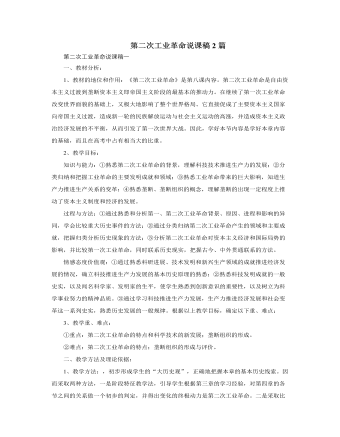
人教版高中历史必修2第二次工业革命说课稿2篇
②内燃机的发明推动了交通运输领域的革新。19世纪末,新型的交通工具——汽车出现了。1885年,德国人卡尔·本茨成功地制成了第一辆用汽油内燃机驱动的汽车。1896年,美国人亨利·福特制造出他的第一辆四轮汽车。与此同时,许多国家都开始建立汽车工业。随后,以内燃机为动力的内燃机车、远洋轮船、飞机等也不断涌现出来。1903年,美国人莱特兄弟制造的飞机试飞成功,实现了人类翱翔天空的梦想,预告了交通运输新纪元的到来。③内燃机的发明推动了石油开采业的发展和石油化学工业的产生。石油也像电力一样成为一种极为重要的新能源。1870年,全世界开采的石油只有80万吨,到1900年猛增至2 000万吨。(3)化学工业的发展:①无机化学工业:用化学反应的方式开始从煤焦油中提炼氨、笨、等,用化学合成的方式,美国人发明了塑料,法国人发明了纤维,瑞典人发明了炸药等。
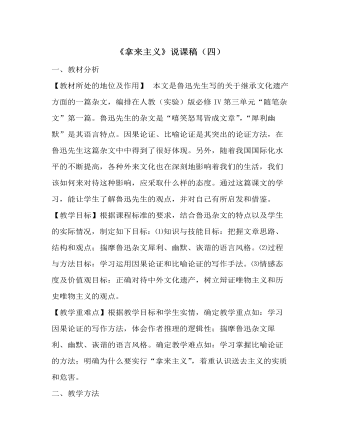
《拿来主义》说课稿(四) 统编版高中语文必修上册
【教学目标】根据课程标准的要求,结合鲁迅杂文的特点以及学生的实际情况,制定如下目标:⑴知识与技能目标:把握文章思路、结构和观点;揣摩鲁迅杂文犀利、幽默、诙谐的语言风格。⑵过程与方法目标:学习运用因果论证和比喻论证的写作手法。⑶情感态度及价值观目标:正确对待中外文化遗产,树立辩证唯物主义和历史唯物主义的观点。【教学重难点】根据教学目标和学生实情,确定教学重点如:学习因果论证的写作方法,体会作者推理的逻辑性;揣摩鲁迅杂文犀利、幽默、诙谐的语言风格。确定教学难点如:学习掌握比喻论证的方法;明确为什么要实行“拿来主义”,着重认识送去主义的实质和危害。二、教学方法教学应坚持“以学生为主体”的原则,尽可能发挥学生学习的能动性和主动性,培养学生独立思考的能力,调动学生学习积极性,因此本文采用“疑问教学法”相对合适。
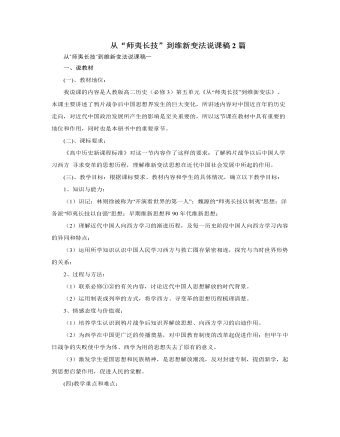
人教版高中历史必修3从“师夷长技”到维新变法说课稿2篇
(一)、教材地位:我说课的内容是人教版高二历史(必修3)第五单元《从“师夷长技”到维新变法》。本课主要讲述了鸦片战争后中国思想界发生的巨大变化,所讲述内容对中国近百年的历史走向,对近代中国政治发展所产生的影响是至关重要的,所以这节课在教材中具有重要的地位和作用,同时也是本册书中的重要章节。(二)、课标要求:《高中历史新课程标准》对这一节内容作了这样的要求:了解鸦片战争以后中国人学习西方 寻求变革的思想历程,理解维新变法思想在近代中国社会发展中所起的作用。(三)、教学目标:根据课标要求、教材内容和学生的具体情况,确立以下教学目标:1、知识与能力:(1)识记:林则徐被称为“开演看世界的第一人”;魏源的“师夷长技以制夷”思想;洋务派“师夷长技以自强”思想;早期维新思想和90年代维新思想;
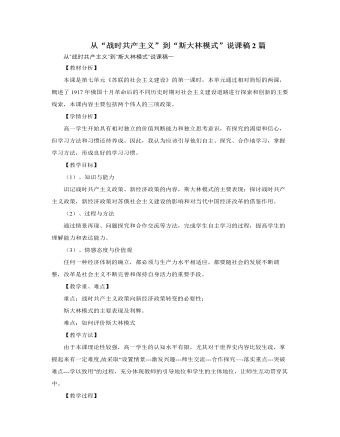
人教版高中历史必修2从“战时共产主义”到“斯大林模式”说课稿2篇
【课堂小结】本课主要讲述俄国十月革命后进行经济建设,并在建设中进行社会主义探索,期间先后出现了战时共产主义政策、新经济政策和斯大林模式,这些政策和体制的产生都是历史和当时现实有关,但也反映出在建设社会主义中既有成功的也由重大失误,主要在于缺乏现成的政策和模式可供借鉴,更在于理论上的缺乏。斯大林模式的形成同苏联当时社会生产力的发展水平相适应,它在初期和战争时期曾发挥了巨大作用,使苏联成为强大的社会主义国家。它建立的高度集中的计划经济体制和新型的工业化模式是苏联进行社会主义建设中的探索和创新,对二战后社会主义国家产生了深刻影响,促进这些国家国民经济的恢复和发展,形成了足以同资本主义相抗衡的社会主义阵营。但是,它没有解决社会主义民主政治建设和经济运行的一系列根本问题,违背了列宁关于把文化经济建设当作工作重心的指示,仍把政治斗争放在第一位。

《念奴娇 赤壁怀古》说课稿(一) 统编版高中语文必修上册
一、说教材:(一)教材的地位和作用《念奴娇﹒赤壁怀古》是部编版高中语文教材必修上册第9课的课文。它与辛弃疾的《永遇乐﹒京口北固亭怀古》,李清照的《声声慢》共同入选该册教材第三单元阅读古诗词,感悟人生这一学习专题。本词是苏轼的代表作,也是豪放词的名篇,在古诗词教学中占有重要的地位。优美的诗词是中华传统文化的瑰宝,学习这些诗词的目的在于培养学生鉴赏古代诗词作品的能力,在分析、鉴赏中感悟前人丰饶的情思,博大的智慧,从而提高学生的人文素养,提高文化品味。这首词写于元丰五年,是苏轼被贬黄州游赤鼻矶所作。本词感情激荡,意境雄浑壮阔。全词融写景、咏史、抒情为一体。通过学习,学生可以获得一些鉴赏诗词的基本要领,领略壮阔意境,感受豪放词风;同时学习苏轼在逆境中依然乐观旷达的人生观。
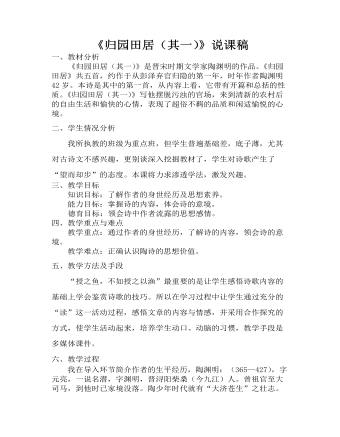
《归园田居(其一)》说课稿 2021-2022学年统编版高中语文必修上册
运用比较法,让学生讨论比较字词改换后与原诗在表达效果上有何异同,然后教师和同学们共同总结出原诗中的画线字词主要运用了比喻和拟人等修辞手法,显得既生动又含蓄,富有意境美,而改后的字词显得直白而又重复。通过文本研读部分的学习,学生对诗歌内容有了较深入的理解,为了使学生拓宽知识面,加强思想价值观的教育引导,在拓展练习部分我设置了一个探究性的问题,让学生谈谈如何看待陶渊明归隐的问题,我采用合作探究法,让学生分组互动讨论、自由发言。教师针对学生的发言,及时地加以点拨:陶渊明不与统治者合作,令人敬佩;歌唱田园风光,令人赞叹;归隐田园有独善其身,消极避世因素,这一点自然不应当苛求古人。

人教版高中语文必修5《说“木叶”》教案
【教学目标】Ⅰ、学习理解诗歌语言的暗示性特质。Ⅱ、根据诗歌语言的特质,进行迁移,领略诗歌的精妙之处,给同学如何鉴赏诗歌提供实感。㈠、导入:各位同学,有个成语叫"一字千金"。对我而言,第一次领略到一个字的分量,是在小学三年级的时候,一次作文评析课上。当时我对自己的文章充满了期待,希望能得到老师的赞赏。记得老师进来后的第一句话是"有一篇文章,我就冲它用了一个字,我给它打95分。打这样的高分,对我来说,是极为难得的。"同学都充满了好奇,老师接着说"这个字就是一个'悟'字。我们的同学都说我学到了,我明白了,我懂得了一个道理,而这位同学却用了一个'悟'字,难能可贵。"这篇文章不是我的,在羡慕的同时,一个字在文章中的分量就深深的刻在了我的心上。文学作品中,一个字精妙与否,足以决定作品是流光溢彩,还是黯然失色。尤其是我们的古典诗词,用简短的几个字,造就的却是丰富的情感与博大的意境。读后满口余香,却是妙处难与君说。这跟诗歌的语言是密不可分的。今天,我们就通过《说"木叶"》一文,对中国古典诗词语言特质作一番探幽。

新人教版高中英语必修2Unit 4 History and Traditions-Discovering Useful Structure教案一
Step 5 Practice一、完成下列句子。1. Judy and I _______________(把车停下来(park))in an underground car Park near Trafalgar Square, where we could ______________________(让我们的车充电(charge)).2. When we finally reached the service desk to ask for audio guides, we heard it ___________ that there were no audio guides____________(留下,剩下).3. We__________________________(发现自己对...很惊讶)the large number of visitors and the amount of noise at the entrance of the National Gallery.4. Judy ____________________(眼神专注于) Van Gogh’s Sunflowers. It was hard to approach the painting as there were so many people around.5. She ____________________(把这幅画的复制品装箱(box)) to ensure that it was delivered safely.答案:1.had our car parked get our car battery charged 2. announced left 3. found ourselves very surprised 4. had her eyes fixed on 5. had a copy of the painting boxed二、用过去分词对下列句子进行改写。1. Loch Ness was surrounded by beautiful natural landscape, which made it look amazing.2. Carl and his friend stayed with a generous family who offered them bread with butter and honey that was homemade.3. The family’s ancestors once attended to soldiers who were wounded in the First World War.4. The young people were attracted by the legend of Loch Ness. They watched over the lake with their cameras and binoculars, which were positioned on the hill.答案:1. Loch Ness surrounded by beautiful natural landscape looks amazing.2. Carl and his friends stayed with a generous family who offered them homemade bread with butter and honey.3. The family’s ancestors once attended to wounded soldiers in the First World War.4. The young people attracted by the legend of Loch Ness watched over the lake with their cameras and binoculars positioned on the hill.

新人教版高中英语必修2Unit 4 History and Traditions-Listening&Speaking&Talking教案一
This unit is about history and traditions. From the opening page, we can know that this unit will introduce the history and traditions around the world. As Marcus Garvey says “A people without the knowledge of their past history, origin and culture is like a tree without roots”, it is important for students to realize the importance and value of knowing the history and traditions and their further meanings. And this part ( listening and speaking ) is divided into two parts: Part A---share views on historic sites, Part B ---talk about a visit to a historic tourist destination. By talking with a foreigner, the speakers introduce the historic attractions and their cultures. Part A is that William, a British student, who was going to visit the Confucius Temple and a Chinese student, Xiao Kong, who was going to the Confucius Temple to meet with the members of the research group, went together and exchanged their views on the Confucius Temple, Confucius, Confucius' descendants and Confucius' educational thoughts. Part B is a conversation between Xiao Yan, a youth hostel receptionist and Paul, a backpacker about the feelings and experience after visiting the Chinese famous tourist attraction Pingyao.1. Guide students to understand the content of listening texts in terms of the whole and key details; 2. Cultivate students' ability to guess the meaning of words in listening; discuss with their peers how to talk about historic spots and great person.3. Instruct students to use functional sentences of showing one’s excitement, surprise and disappointment.1. Guide students to understand the content of listening texts in terms of the whole and key details; 2. Cultivate students' ability to discuss with their peers the related topics.3. Enable students to use the functional items of showing one’s excitement, surprise and disappointment.

新人教版高中英语必修2Unit 4 History and Traditions-Reading and Thinking教案一
Features of languages1.Finally, in the 20th century, the southern part of Ireland broke away from the UK, which resulted in the full name we have today: the United Kingdom of Great Britain and Northern Ireland.该句是一个复合句。该句主句为:the southern part of Ireland broke away from the UK;which resulted in the full name we have today为which引导的定语从句代指前面整句话的内容,we have today为定语从句修饰先行词name。译文:最后,在20世纪,爱尔兰南部脱离英国,这导致了我们今天有的英国的全名:大不列颠及北爱尔兰联合王国。2.Almost everywhere you go in the UK, you will be surrounded by evidence of four different groups of people who took over at different times throughout history.该句是一个复合句。该句主句为:you will be surrounded by evidence of four different groups of people;其中Almost everywhere you go in the UK为让步状语从句; who took over at different times throughout history为定语从句修饰先行词people。译文:几乎无论你走到英国的任何地方,你都会发现历史上有四种不同的人在不同的时期统治过英国。3.The capital city London is a great place to start, as it is an ancient port city that has a history dating all the way back to Roman times.该句是一个复合句。该句主句为:The capital city London is a great place to start; as it is an ancient port city that has a history dating all the way back to Roman times.为原因状语从句;dating all the way back to Roman times为现在分词短语作定语修饰history。

新人教版高中英语必修3Unit 1 Festivals and Celebrations教学设计一
本板块的活动主题是“谈论节日活动”(Talk about festival activities),主要是从贴近学生日常生活的角度来切入“节日”主题。学生会听到发生在三个国家不同节日场景下的简短对话,对话中的人们正在参与或将要亲历不同的庆祝活动。随着全球化的进程加速,国际交流日益频繁,无论是国人走出国门还是外国友人访问中国,都已成为司空见惯的事情。因此,该板块所选取的三个典型节日场景都是属于跨文化交际语境,不仅每组对话中的人物来自不同的文化背景,对话者的身份和关系也不尽相同。1. Master the new words related to holiday: the lantern, Carnival, costume, dress(sb)up, march, congratulation, congratulate, riddle, ceremony, samba, make - up, after all. 2. To understand the origin of major world festivals and the activities held to celebrate them and the significance of these activities;3. Improve listening comprehension and oral expression of the topic by listening and talking about traditional festivals around the world;4. Improve my understanding of the topic by watching pictures and videos about different traditional festivals around the world;5. Review the common assimilation phenomenon in English phonetics, can distinguish the assimilated phonemes in the natural language flow, and consciously use the assimilation skill in oral expression. Importance:1. Guide students to pay attention to the attitude of the speaker in the process of listening, and identify the relationship between the characters;2. Inspire students to use topic words to describe the festival activities based on their background knowledge. Difficulties:In the process of listening to the correct understanding of the speaker's attitude, accurately identify the relationship between the characters.

新人教版高中英语必修3Unit 2 Morals and virtues教学设计一
(2) students are divided into groups according to the requirements of activity 3. Each student shares a story of personal experience or hearing-witnessing kindness, and then selects the most touching story in the group and shares it with the whole class. Before the students share the story, the teacher can instruct them to use the words and sentence patterns in the box to express. For example, the words in the box can be classified:Time order: first of all, then, after that, later, finally logical relationship :so, however, although, butTeachers can also appropriately add some transitional language to enrich students' expression:Afterwards, afterwards, at last, in the end, eventuallySpatial order: next to, far from, on the left, in front ofOtherwise, nevertheless, as a result, therefore, furthermore, in addition, as well asSummary: in a word, in short, on the whole, to sum up, in briefStep 8 Homework1. Understand the definition of "moral dilemma" and establish a correct moral view;2. Accumulate vocabulary about attitudes and emotions in listening texts and use them to express your own views;3. Complete relevant exercises in the guide plan.1、通过本节内容学习,学生能否理解理解“道德困境”的定义;2、通过本节内容学习,学生能否通过说话人所表达的内容、说话的语气、语调等来判断其态度和情绪;3、通过本节内容学习,学生能否针对具体的道德困境发表自己的看法和见解,能否掌握听力理训练中的听力策略。

新人教版高中英语必修3Unit 3 Diverse Cultures教学设计一
Activity 81.Grasp the main idea of the listening.Listen to the tape and answer the following questions:Who are the two speakers in the listening? What is their relationship?What is the main idea of the first part of the listening? How about the second part?2.Complete the passage.Ask the students to quickly review the summaries of the two listening materials in activity 2. Then play the recording for the second time.Ask them to complete the passage and fill in the blanks.3.Play the recording again and ask the students to use the structure diagram to comb the information structure in the listening.(While listening, take notes. Capture key information quickly and accurately.)Step 8 Talking Activity 91.Focus on the listening text.Listen to the students and listen to the tape. Let them understand the attitudes of Wu Yue and Justin in the conversation.How does Wu Yue feel about Chinese minority cultures?What does Justin think of the Miao and Dong cultures?How do you know that?2.learn functional items that express concerns.Ask students to focus on the expressions listed in activity. 3.And try to analyze the meaning they convey, including praise (Super!).Agree (Exactly!)"(You're kidding.!)Tell me more about it. Tell me more about it.For example, "Yeah Sure." "Definitely!" "Certainly!" "No kidding!" "No wonder!" and so on.4.Ask the students to have conversations in small groups, acting as Jsim and his friends.Justin shares his travels in Guizhou with friends and his thoughts;Justin's friends should give appropriate feedback, express their interest in relevant information, and ask for information when necessary.In order to enrich the dialogue, teachers can expand and supplement the introduction of Miao, dong, Lusheng and Dong Dage.After the group practice, the teacher can choose several groups of students to show, and let the rest of the students listen carefully, after listening to the best performance of the group, and give at least two reasons.
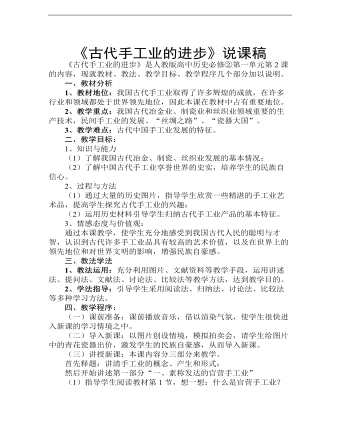
高中历史人教版必修二《第2课古代手工业的进步》说课稿
二、教学目标:1、知识与能力(1)了解我国古代冶金、制瓷、丝织业发展的基本情况;(2)了解中国古代手工业享誉世界的史实,培养学生的民族自信心。2、过程与方法(1)通过大量的历史图片,指导学生欣赏一些精湛的手工业艺术品,提高学生探究古代手工业的兴趣;(2)运用历史材料引导学生归纳古代手工业产品的基本特征。3、情感态度与价值观:通过本课教学,使学生充分地感受到我国古代人民的聪明与才智,认识到古代许多手工业品具有较高的艺术价值,以及在世界上的领先地位和对世界文明的影响,增强民族自豪感。

人教版新课标高中物理必修2生活中的圆周运动说课稿3篇
(一)地位《生活中的圆周运动》这节课是新课标人教版《物理》必修第二册第5章《曲线运动》一章中的第7节,也是该章最后一节。本节课是在学生学习了圆周运动、向心加速度、向心力以后的一节应用课,通过研究圆周运动规律在生活中的具体应用,使学生深入理解圆周运动规律,并且结合日常生活中的某些生活体验,加深物理知识在头脑中的印象。(二)教材处理教材中的“火车转弯”与“汽车过拱桥”根据学生接受的难易程度,顺序作了对调,并把最后一部分“离心运动”放到下一节课处理。(三)教学目标1.知识与技能目标(1)进一步加深对向心力的认识,会在实际问题中分析向心力的来源。(2)培养学生独立观察、分析问题、解决问题的能力,提高学生概括总结知识的能力。(3)了解航天器中的失重现象。2.过程与方法目标(1)学会分析圆周运动方法,会分析拱形桥、弯道等实际的例子,培养理论联系实际的能力。
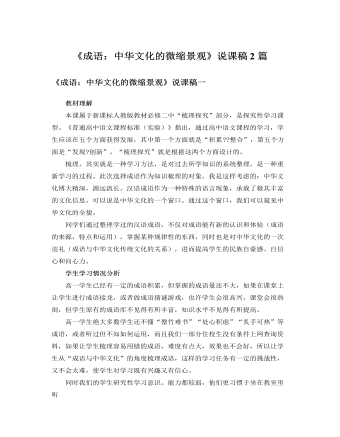
人教版高中语文必修2《成语:中华文化的微缩景观》说课稿2篇
(三)教学目标1、明确成语的来源,了解成语的结构特点。2、学习积累成语的方法。3、梳理学习过的成语,做到能正确理解、使用所学的常用成语。(四)教学重点和难点1、学习积累成语的方法。2、正确理解、使用所学的常用成语。二、说教法新的《高中语文课程标准》要求学生主动去发现问题、解决问题,教师是课堂学习的组织者、参与者,是课堂的主导,而不是课堂的主体。而且,新的课程标准要求学生“能围绕所选择的目标加强语文积累,在积累的过程中,注重梳理”。在这种前提下,本节课可以采取以下方法:由于这种梳理是对学生已有的知识进行归纳分类,可能显得比较枯燥。为了避免这种枯燥感,可以采取设置情境和分组竞答的方法,调动学生的积极性。
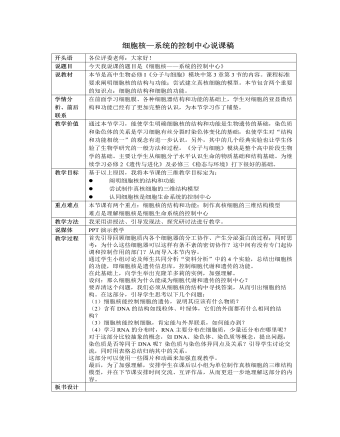
人教版高中生物必修1细胞核—系统的控制中心说课稿
首先引导回顾细胞质内各个细胞器的分工协作、产生分泌蛋白的过程;同时思考:为什么这些细胞器可以这样有条不紊的密切协作?这中间有没有专门起协调和控制作用的部门?从而导入本节内容。通过学生小组讨论及师生共同分析“资料分析”中的4个实验,总结出细胞核的功能,即细胞核是遗传信息库,控制细胞代谢和遗传的功能。在此基础上,向学生举出克隆羊多莉的实例,加强理解。设问:那么细胞核为什么能成为细胞代谢和遗传的控制中心?要弄清这个问题,我们必须从细胞核的结构中寻找答案,从而引出细胞的结构。在这部分,引导学生思考以下几个问题:(1)细胞核能控制细胞的遗传,说明其应该有什么物质?(2)含有DNA的结构如线粒体、叶绿体,它们的外面都有什么相同的结构?(3)细胞核能控制细胞,肯定能与外界联系,如何能办到?(4)学习RNA的分布时,RNA主要分布在细胞质,少量还分布在哪里呢?
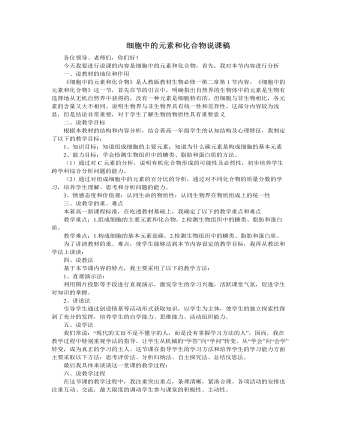
人教版高中生物必修1细胞中的元素和化合物说课稿
一、说教材的地位和作用《细胞中的元素和化合物》是人教版教材生物必修一第二章第1节内容。《细胞中的元素和化合物》这一节,首先在节的引言中,明确指出自然界的生物体中的元素是生物有选择地从无机自然界中获得的,没有一种元素是细胞特有的。但细胞与非生物相比,各元素的含量又大不相同。说明生物界与非生物界具有统一性和差异性。这部分内容较为浅显,但是结论非常重要,对于学生了解生物的物质性具有重要意义二、说教学目标根据本教材的结构和内容分析,结合着高一年级学生的认知结构及心理特征,我制定了以下的教学目标:1、知识目标:知道组成细胞的主要元素;知道为什么碳元素是构成细胞的基本元素2、能力目标:学会检测生物组织中的糖类、脂肪和蛋白质的方法。(1)通过对C元素的分析,说明有机化合物形成的可能性及必然性,初步培养学生跨学科综合分析问题的能力。(2)通过对组成细胞中的元素的百分比的分析,通过对不同化合物的质量分数的学习,培养学生理解、思考和分析问题的能力。
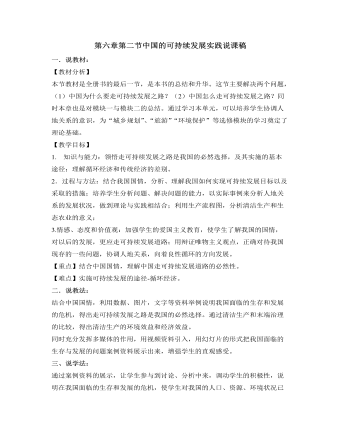
人教版高中地理必修2第六章第二节中国的可持续发展实践说课稿
1.导入新课:用触目精心的一首MTV《EARTHSONG》导入新课,引出人类已经面临严峻的人口、资源与环境的危机。而中国是世界上人口最庞大的国家,人口、资源与环境问题更加严重。既然我们知道了可持续发展的概况,了解了它的发展过程,从上节课内容的分析中,也理解了作为人类的发展,可持续是唯一的选择,也是我们所追求的目标,那么,具体到我们国家、我们周围的生产、生活情况又该如何呢?2.新课讲授:首先,通过三则补充材料的案例和课本上的内容分别说明庞大的人口压力,资源短缺和不合理利用,深刻的环境危机方面的问题,得出走可持续发展之路是我国的必然的唯一的选择。接着通过《中国21世纪议程》——中国21世纪人口环境与发展的白皮书的过渡引出实施可持续发展的途径。在这部分内容的讲解上,主要通过其中一种主要途径-循环经济的讲解,特别是对清洁生产和生态农业的具体分析,总结出中国走可持续发展之路事在必行,行必有果。再通过完成课本上最后一个活动题对本节内容进行深化。
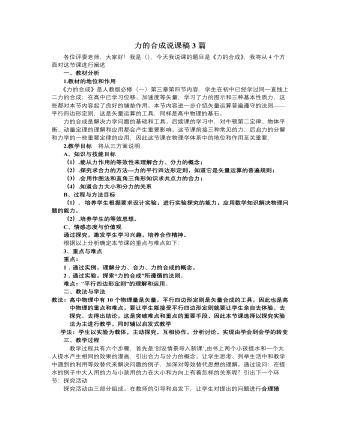
人教版新课标高中物理必修1力的合成说课稿3篇
① 实验设计将学生分组,利用桌上的器材进行探究(幻灯片展示)这个实验难度较大,为了降低难度,为实验探究铺下第二台阶,要求学生先分小组讨论以下问题(幻灯片展示)有些学生可能不知如何下手,我会要求学生先阅读课本中的实验描述从中得到一点提示,再让一两个小组同学回答,这样既体现了学生学习的主体性又可提高学生自主思考和语言表达能力,之后我再进行补充完善(幻灯片展示答案),并用幻灯片把实验步骤展示出来,在学生实验过程一直保留,使学生能朝正确的方向进行猜想和操作,为实验探究铺下第三个台阶。② 实施探究在学生分组进行探究过程,教师巡视解惑,随时观察学生情况,解答学生提出的问题,还可用自言自语方式提示应注意的一些问题,如仪器的正确使用,操作的规范等,帮助学生尽量在规定时间内顺利完成实验。